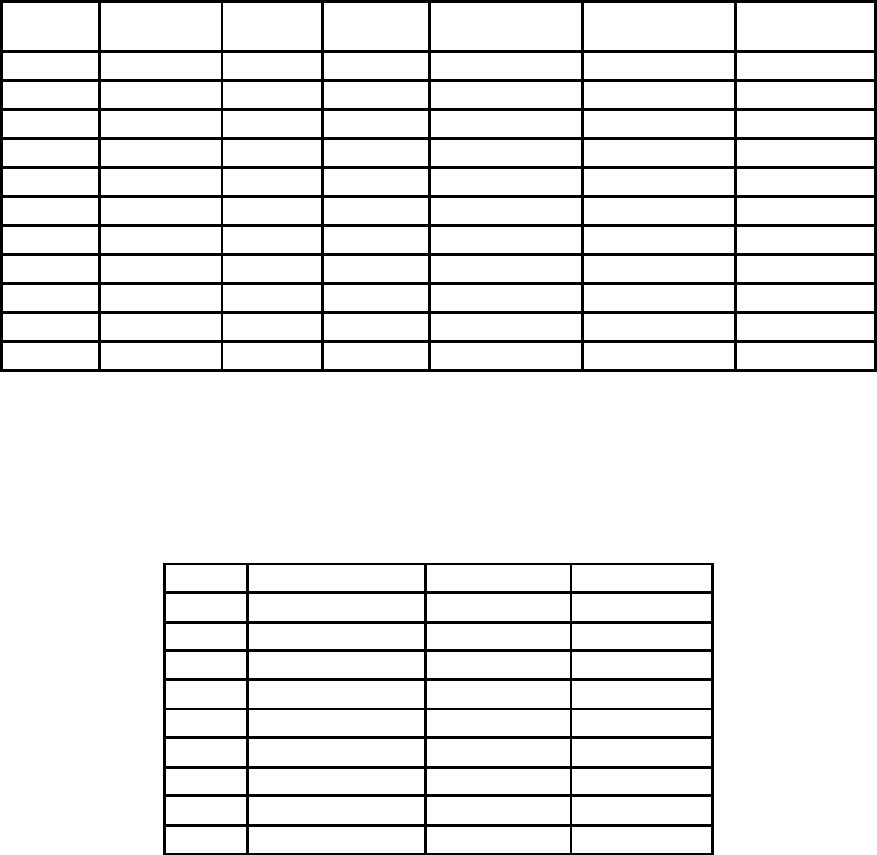Damodaran A. Applied corporate finance
Подождите немного. Документ загружается.


47
47
While the approach described above will provide the precise value, there are two
short cuts available. One is to divide the value of equity by the fully diluted
29
number of
shares outstanding rather than by the actual number. This approach will underestimate the
value of the equity, because it fails to consider the cash proceeds from option exercise.
The other shortcut, which is called the treasury stock approach, adds the expected
proceeds from the exercise of the options (exercise price multiplied by the number of
options outstanding) to the numerator before dividing by the number of shares
outstanding. While this approach will yield a more reasonable estimate than the first one,
it does not include the time value of the options outstanding. Thus, it tends to overstate
the value of the common stock.
warrants.xls: This spreadsheet allows you to value the options outstanding in a firm,
allowing for the dilution effect.
Illustration 12.10: Value of Equity Options
Disney has granted considerable numbers of options to its managers. At the end of
2003, there were 219 million options outstanding, with a weighted average exercise price
of $26.44 and weighted average life of 6 years. Using the current stock price of $26.91,
an estimated standard deviation
30
of 40, a dividend yield of 1.21%. a riskfree rate of 4%
and an option pricing model, we estimate the value of these equity options to $2.129
billion.
31
The value we have estimated for the options above are probably too high, since
we assume that all the options are exercisable. In fact, a significant proportion of these
options (about 50%) are not vested
32
yet, and this fact will reduce their estimated value.
We will also assume that these options, when exercised, will generate a tax benefit to the
firm equal to 37.3% of their value:
After-tax value of equity options = 2129 (1-.373) = $1334.67 million
29
We assume that all options will be exercised, and compute the number of shares that will be outstanding
in that event.
30
We used the historical standard deviation in Boeing’s stock price to estimate this number.
31
The option pricing model used is the Black-Scholes model. It is described in more detail in the appendix.
32
When options are not vested, they cannot be exercised. Firms, when providing options to their
employees, firms often require that they continue as employees for a set period before they can exercise
these options.

48
48
Reconciling Equity and Firm Valuations
This model, unlike the dividend discount model or the FCFE model, values the
firm rather than equity. The value of equity, however, can be extracted from the value of
the firm by subtracting out the market value of outstanding debt. Since this model can be
viewed as an alternative way of valuing equity, two questions arise - Why value the firm
rather than equity? Will the values for equity obtained from the firm valuation approach
be consistent with the values obtained from the equity valuation approaches described in
the previous chapter?
The advantage of using the firm valuation approach is that cashflows relating to
debt do not have to be considered explicitly, since the FCFF is a pre-debt cashflow, while
they have to be taken into account in estimating FCFE. In cases where the leverage is
expected to change significantly over time, this is a significant saving, since estimating
new debt issues and debt repayments when leverage is changing can become increasingly
messy the further into the future you go. The firm valuation approach does, however,
require information about debt ratios and interest rates to estimate the weighted average
cost of capital.
The value for equity obtained from the firm valuation and equity valuation
approaches will be the same if you make consistent assumptions about financial leverage.
Getting them to converge in practice is much more difficult. Let us begin with the
simplest case – a no-growth, perpetual firm. Assume that the firm has $166.67 million in
earnings before interest and taxes and a tax rate of 40%. Assume that the firm has equity
with a market value of $600 million, with a cost of equity of 13.87%, and debt of $400
million, with a pre-tax cost of debt of 7%. The firm’s cost of capital can be estimated:
Cost of capital =
( ) ( )( )
10%
1000
400
0.4-17%
1000
600
13.87% =
!
"
#
$
%
&
+
!
"
#
$
%
&
Value of the firm =
( ) ( )
$1,000
0.10
0.4-1166.67
capital ofCost
t-1EBIT
==
Note that the firm has no reinvestment and no growth. We can value equity in this firm
by subtracting out the value of debt.
Value of equity = Value of firm – Value of debt = $ 1,000 - $400 = $ 600 million
Now let us value the equity directly by estimating the net income:

49
49
Net Income = (EBIT – Pre-tax cost of debt * Debt) (1-t) = (166.67 - 0.07*400) (1-0.4) =
83.202 million
The value of equity can be obtained by discounting this net income at the cost of equity:
Value of equity =
million 600 $
0.1387
83.202
equity ofCost
IncomeNet
==
Even this simple example works because of the following assumptions that we made
implicitly or explicitly during the valuation.
1. The values for debt and equity used to compute the cost of capital were equal to
the values that we obtained in the valuation. Notwithstanding the circularity in
reasoning – you need the cost of capital to obtain the values in the first place – it
indicates that a cost of capital based upon market value weights will not yield the
same value for equity as an equity valuation model, if the firm is not fairly priced
in the first place.
2. There are no extraordinary or non-operating items that affect net income but not
operating income. Thus, to get from operating to net income, all we do is subtract
out interest expenses and taxes.
3. The interest expenses are equal to the pre-tax cost of debt multiplied by the
market value of debt. If a firm has old debt on its books, with interest expenses
that are different from this value, the two approaches will diverge.
If there is expected growth, the potential for inconsistency multiplies. You have to ensure
that you borrow enough money to fund new investments to keep your debt ratio at a level
consistent with what you are assuming when you compute the cost of capital.
fcffvsfcfe.xls: This spreadsheet allows you to compare the equity values obtained
using FCFF and FCFE models.
Illustration 12.11: FCFF Valuation: Disney
To value Disney, we will consider all of the numbers that we have estimated
already in this section. Recapping those estimates:
- The operating income in 2003, before taxes and adjusted for operating leases, is
$2,805 million. While this represents a significant come back from the doldrums of
2002, it is still lower than the operating income in the 1990s and results in an after-tax
return on capital of only 4.42% (assuming a tax rate of 37.30%).

50
50
- For years 1 through 5, we will assume that Disney will be able to raise its return on
capital on new investments to 12% and that the reinvestment rate will be 60%. (See
illustration 12.6). This will result in an expected growth rate of 7.20% a year.
- For years 1 through 5, we will assume that Disney will maintain its existing debt ratio
of 21% and its current cost of capital of 8.59% (see illustration 12.7).
- The assumptions for stable growth (after year 10) and for the transition period are
listed in illustration 12.8.
In table 12.4, we estimate the after-tax operating income, reinvestment and free cashflow
to the firm each year for the next 10 years:
Table 12.4: Estimated Free Cashflows to the Firm - Disney
Year
Expected
Growth
EBIT
EBIT (1-
t)
Reinvestment
Rate
Reinvestment
FCFF
Current
$2,805
1
6.38 %
$2,984
$1,871
53.18 %
$994.92
$876.06
2
6.38 %
$3,174
$1,990
53.18 %
$1,058.41
$931.96
3
6.38 %
$3,377
$2,117
53.18 %
$1,125.94
$991.43
4
6.38 %
$3,592
$2,252
53.18 %
$1,197.79
$1,054.70
5
6.38 %
$3,822
$2,396
53.18 %
$1,274.23
$1,122.00
6
5.90 %
$4,047
$2,538
50.54 %
$1,282.59
$1,255.13
7
5.43 %
$4,267
$2,675
47.91 %
$1,281.71
$1,393.77
8
4.95 %
$4,478
$2,808
45.27 %
$1,271.19
$1,536.80
9
4.48 %
$4,679
$2,934
42.64 %
$1,250.78
$1,682.90
10
4.00 %
$4,866
$3,051
40.00 %
$1,220.41
$1,830.62
In table 12.5, we estimate the present value of the free cashflows to the firm using the
cost of capital Since the beta and debt ratio change each year from year 6 to 10, the cost
of capital also changes each year.
Table 12.5: Present Value of Free Cashflows to Firm – Disney
Year
Cost of capital
FCFF
PV of FCFF
1
8.59 %
$876.06
$806.74
2
8.59 %
$931.96
$790.31
3
8.59 %
$991.43
$774.21
4
8.59 %
$1,054.70
$758.45
5
8.59 %
$1,122.00
$743.00
6
8.31 %
$1,255.13
$767.42
7
8.02 %
$1,393.77
$788.91
8
7.73 %
$1,536.80
$807.42
9
7.45 %
$1,682.90
$822.90

51
51
10
7.16 %
$1,830.62
$835.31
PV of cashflows during high growth =
$7,894.66
To compute the present value of the cashflows in years 6 through 10, we have to use the
compounded cost of capital over the previous years. To illustrate, the present value of
$1536.80 million in cashflows in year 8 is:
Present value of cashflow in year 8 =
!
1536.80
(1.0859)
5
(1.0831)(1.0802)(1.0773)
The final piece of the valuation is the terminal value. To estimate the terminal value, at
the end of year 10, we estimate the free cashflow to the firm in year 11:
FCFF
11
= EBIT
11
(1-t) (1- Reinvestment Rate
Stable Growth
)/
= 4866 (1.04) (1-.40) = $1,903.84 million
Terminal Value = FCFF
11
/ (Cost of capital
Stable Growth
– g)
= 1903.84/ (.0716 - .04) = $60,219.11 million
The value of the firm is the sum of the present values of the cashflows during the high
growth period, the present value of the terminal value and the value of the non-operating
assets that we estimated in illustration 12.9.
PV of cashflows during the high growth phase =$ 7,894.66
PV of terminal value=
!
60,219.11
(1.0859)
5
(1.0831)(1.0802)(1.0773)(1.0745)(1.0716)
=$ 27,477.81
+ Cash and Marketable Securities =$ 1,583.00
+ Non-operating Assets (Holdings in other companies) =$ 1,849.00
Value of the firm =$ 38,804.48
Subtracting out the market value of debt (including operating leases) of $14,668.22
million and the value of the equity options (estimated to be worth $1,334.67 million in
illustration 12.10) yields the value of the common stock:
Value of equity in common stock = Value of firm – Debt – Equity Options
= $38,804.48 - $14,668.22 - $1334.67 = $ 22,801.59
Dividing by the number of shares outstanding (2047.60 million), we arrive at a value per
share o $11.14, well below the market price of $ 26.91 at the time of this valuation.
12.10. ☞: Net Capital Expenditures and Value

52
52
In the valuation above, we assumed that the reinvestment rate would be 40% in
perpetuity to sustain the 4% stable growth rate. What would the terminal value have been
if, instead, we had assumed that the reinvestment rate was zero, while continuing to use a
stable growth rate of 4%?
In Practice: Adjusted Present Value (APV)
In chapter 8, we presented the adjusted present value approach to estimate the
optimal debt ratio for a firm. In that approach, we begin with the value of the firm
without debt. As we add debt to the firm, we consider the net effect on value by
considering both the benefits and the costs of borrowing. To do this, we assume that the
primary benefit of borrowing is a tax benefit and that the most significant cost of
borrowing is the added risk of bankruptcy.
The first step in this approach is the estimation of the value of the unlevered firm.
This can be accomplished by valuing the firm as if it had no debt, i.e., by discounting the
expected free cash flow to the firm at the unlevered cost of equity. In the special case
where cash flows grow at a constant rate in perpetuity, the value of the firm is easily
computed.
Value of Unlevered Firm =
( )
g -
g1FCFF
u
o
!
+
where FCFF
0
is the current after-tax operating cash flow to the firm, ρ
u
is the unlevered
cost of equity and g is the expected growth rate. In the more general case, you can value
the firm using any set of growth assumptions you believe are reasonable for the firm.
The second step in this approach is the calculation of the expected tax benefit
from a given level of debt. This tax benefit is a function of the tax rate of the firm and is
discounted at the cost of debt to reflect the riskiness of this cash flow. If the tax savings
are viewed as a perpetuity,
Value of Tax Benefits
( )( )( )
( )( )
Dt
c
=
=
=
DebtRateTax
Debt ofCost
DebtDebt ofCost RateTax

53
53
The tax rate used here is the firm’s marginal tax rate and it is assumed to stay constant
over time. If we anticipate the tax rate changing over time, we can still compute the
present value of tax benefits over time, but we cannot use the perpetual growth equation
cited above.
The third step is to evaluate the effect of the given level of debt on the default risk
of the firm and on expected bankruptcy costs. In theory, at least, this requires the
estimation of the probability of default with the additional debt and the direct and indirect
cost of bankruptcy. If π
a
is the probability of default after the additional debt and BC is
the present value of the bankruptcy cost, the present value of expected bankruptcy cost
can be estimated.
PV of Expected Bankruptcy cost
( )( )
BC
a
!
=
= Cost Bankruptcy of PVBankruptcy ofy Probabilit
This step of the adjusted present value approach poses the most significant estimation
problem, since neither the probability of bankruptcy nor the bankruptcy cost can be
estimated directly.
In theory, the APV approach and the cost of capital approach will yield the same
values for a firm if consistent assumptions are made about financial leverage. The
difficulties associated with estimating the expected bankruptcy cost, though, often lead
many to use an abbreviated version of the APV model, where the tax benefits are added
to the unlevered firm value and bankruptcy costs are ignored. This approach will over
value firms.
Valuing Private Businesses
All of the principles that we have developed for valuation apply to private
companies as well. In other words, the value of a private company is the present value of
the expected cashflows that you would expect that company to generate over time,
discounted back at a rate that reflects the riskiness of the cashflows. The differences that
exist are primarily in the estimation of the cashflows and the discount rates:
- When estimating cashflows, we should keep in mind that while accounting standards
may not be adhered to consistently in publicly traded firms, they can diverge
dramatically in private firms. In small, private businesses, we should reconstruct
financial statements rather than trust the earnings numbers that are reported. There are
54
54
also two common problems that arise in private firm accounting that we have to
correct for. The first is the failure on the part of many owners to attach a cost to the
time that they spend running their businesses. Thus, the owner of a store who spends
most of every day stocking the store shelves, manning the cash register and
completing the accounting will often not show a salary associated with these activities
in her income statement, resulting in overstated earnings. The second is the
intermingling of personal and business expenses that is endemic in many private
businesses. When re-estimating earnings, we have to strip the personal expenses out
of the analysis.
- When estimating discount rates for publicly traded firms, we hewed to two basic
principles. With equity, we argued that the only risk that matters is the risk that
cannot be diversified away by marginal investors, who we assumed were well
diversified. With debt, the cost of debt was based upon a bond rating and the default
spread associated with that rating. With private firms, both these assumptions will
come under assault. First, the owner of a private business is almost never diversified
and has his or her entire wealth often tied up in the firm’s assets. That is why we
developed the concept of a total beta for private firms in chapter 4, where we scaled
the beta of the firm up to reflect all risk and not just non-diversifiable risk. Second,
private businesses usually have to borrow from the local bank and do not have the
luxury of accessing the bond market. Consequently, they may well find themselves
facing a higher cost of debt than otherwise similar publicly traded firms.
- The final issue relates back to terminal value. With publicly traded firms, we assume
that firms have infinite lives and use this assumption, in conjunction with stable
growth, to estimate a terminal value. Private businesses, especially smaller ones,
often have finite lives since they are much more dependent upon the owner/founder
for their existence.
With more conservative estimates of cashflows, higher discount rates to reflect the
exposure to total risk and finite life assumptions, it should come as no surprise that the
values we attach to private firms are lower than those that we would attach to otherwise
similar publicly traded firms. This also suggests that private firms that have the option of

55
55
becoming publicly traded will generally succumb to that temptation even though the
owners might not like the oversight and loss of control that comes with this transition.
Illustration 12.12: Valuing a Private Business: Bookscape
To value Bookscape, we will use the operating income of $2 million that the firm
had in its most recent year as a starting point. Adjusting for the operating lease
commitments that the firm has, we arrive at an adjusted operating income of $2,368.88
million.
33
To estimate the cost of capital, we draw on the estimates of total beta and the
assumption that the firm’s debt to capital ratio would resemble the industry average of
16.90% that we made in chapter 4 (see illustration 4.16):
Cost of capital = Cost of equity (D/(D+E)) + After-tax cost of debt (D/(D+E))
= 13.93% (.831) + 5.50% (1-.4) (.169) = .1214 or 12.14%
The total beta for Bookscape is 2.06 and we will continue to use the 40% tax rate for the
firm.
In chapter 5, we estimated a return on capital for Bookscape of 12.68% and we
will assume that the firm will continue to generate this return on capital for the next 40
years, while growing its earnings at 4% a year. The resulting reinvestment rate is 31.54%:
Reinvestment rate = Growth rate/ Return on capital = 4%/12.68% = 31.54%
The present value of the cashflows, assuming perpetual growth, can be computed as
follows:
Value of operating assets = 2,368.88 (1-.40)(1-.3154)/(.1214-.04) = $12.483 million
Value of cash holdings = $ 2.500 million
Value of the firm = $ 14.939 million
- Value of debt (operating leases) = $ 6.707 million
Value of equity = $ 8.231 million
If we wanted to be conservative, and assume that the cashflows will continue for only 40
years, the value of the operating assets drops marginally to $12.3 million.
In Practice: Illiquidity Discounts in Private Firm Valuation
33
In illustration 4.15, we estimated the present value of the operating lease commitments at Bookscape to
be $6.7 million. To adjust the operating income, we add back the imputed interest expense on this debt,

56
56
If you buy stock in a publicly traded firm and change your mind and decide to
sell, you face modest transactions costs. If you buy a private business and change your
mind, it is far more difficult to reverse your decision. As a consequence, many analysts
valuing private businesses apply an illiquidity discount that ranges from 20 to 40% of the
value to arrive at a final value. While the size of the discount is large, there is surprisingly
little thought that seems to go into the magnitude of the discount. In fact, it is almost
entirely based on studies of restricted stock issued by publicly traded firms. These stock
are placed with investors who are restricted from trading on the stock for 2 years after the
issue and the price on the issue can be compared to the market price of the traded shares
of the company to get a sense of the discount that investors demand for the enforced
illiquidity. Since there are relatively few restricted stock issues, the sample sizes tend to
be small and involve companies that may have other problems raising fresh funds.
While we concede the necessity of an illiquidity discounts in the valuation of
private businesses, the discount should be adjusted to reflect the characteristics of the
firm in question, Other things remaining equal, we would expect smaller firms with less
liquid assets and in poorer financial health to have much larger illiquidity discounts
attached to their values. One way to make this adjustment is to take a deeper look at the
restricted stock issues for which we have data and look at reasons for the differences in
discounts across stocks.
34
Another way is to view the bid-ask spread as the illiquidity
discount on publicly traded companies and extend an analysis of the determinants of bid-
ask spreads to come up with a reasonable measure of the bid-ask spread or illiquidity
discount of a private business.
35
Value Enhancement
In a discounted cashflow valuation, the value of a firm is the function of four key
inputs – the cashflows from existing investments, the expected growth rate in these
cashflows for the high growth period, the length of time before the company becomes a
obtained by multiplying the pre-tax cost of borrowing (5.5%) by the present value of the operating leases
(6.7 m))
34
Silber did this in a 1989 study, where he found that the discount tended to be larger for companies with
smaller revenues and negative earnings.
35
See Investment Valuation (John Wiley and Sons) for more details.
